名词前不加冠词的几种情况
- 格式:doc
- 大小:13.00 KB
- 文档页数:1
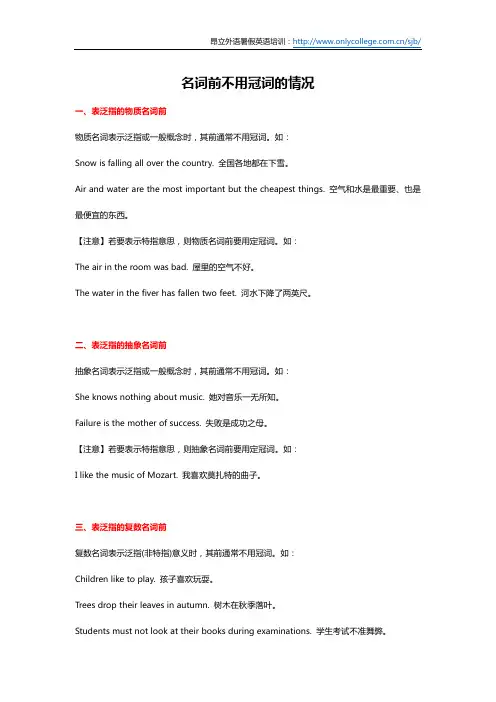
名词前不用冠词的情况一、表泛指的物质名词前物质名词表示泛指或一般概念时,其前通常不用冠词。
如:Snow is falling all over the country. 全国各地都在下雪。
Air and water are the most important but the cheapest things. 空气和水是最重要、也是最便宜的东西。
【注意】若要表示特指意思,则物质名词前要用定冠词。
如:The air in the room was bad. 屋里的空气不好。
The water in the fiver has fallen two feet. 河水下降了两英尺。
二、表泛指的抽象名词前抽象名词表示泛指或一般概念时,其前通常不用冠词。
如:She knows nothing about music. 她对音乐一无所知。
Failure is the mother of success. 失败是成功之母。
【注意】若要表示特指意思,则抽象名词前要用定冠词。
如:I like the music of Mozart. 我喜欢莫扎特的曲子。
三、表泛指的复数名词前复数名词表示泛指(非特指)意义时,其前通常不用冠词。
如:Children like to play. 孩子喜欢玩耍。
Trees drop their leaves in autumn. 树木在秋季落叶。
Students must not look at their books during examinations. 学生考试不准舞弊。
【注意】若表示特指意义,复数名词前应用定冠词。
如:The children are playing in the yard. 孩子们在院子里玩。
She stopped at the first of the trees. 她在第一棵树前停了下来。
四、节假日及星期或月份等前按英语习惯,在节假日、星期、月份等通常不用冠词。
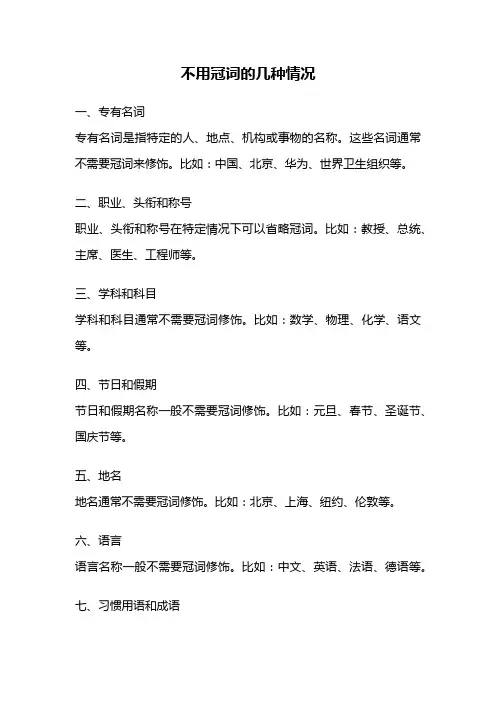
不用冠词的几种情况
一、专有名词
专有名词是指特定的人、地点、机构或事物的名称。
这些名词通常不需要冠词来修饰。
比如:中国、北京、华为、世界卫生组织等。
二、职业、头衔和称号
职业、头衔和称号在特定情况下可以省略冠词。
比如:教授、总统、主席、医生、工程师等。
三、学科和科目
学科和科目通常不需要冠词修饰。
比如:数学、物理、化学、语文等。
四、节日和假期
节日和假期名称一般不需要冠词修饰。
比如:元旦、春节、圣诞节、国庆节等。
五、地名
地名通常不需要冠词修饰。
比如:北京、上海、纽约、伦敦等。
六、语言
语言名称一般不需要冠词修饰。
比如:中文、英语、法语、德语等。
七、习惯用语和成语
习惯用语和成语中的名词通常不需要冠词修饰。
比如:心上人、路上人、吃饭穿衣等。
八、时间表达
时间表达中的星期、月份、季节等通常不需要冠词修饰。
比如:星期一、七月、夏天等。
九、序数词和基数词
序数词和基数词通常不需要冠词修饰。
比如:第一、十二、一百等。
十、部分漏掉冠词的固定短语
有些固定短语中的名词会省略冠词,例如:上学、下班、回家、去医院、上楼、下车等。
以上是一些常见的不用冠词的情况。
在使用时,我们需要根据具体的语境来判断是否需要使用冠词。
正确地使用冠词可以使语言更加准确、流畅。
希望以上内容对您有所帮助。
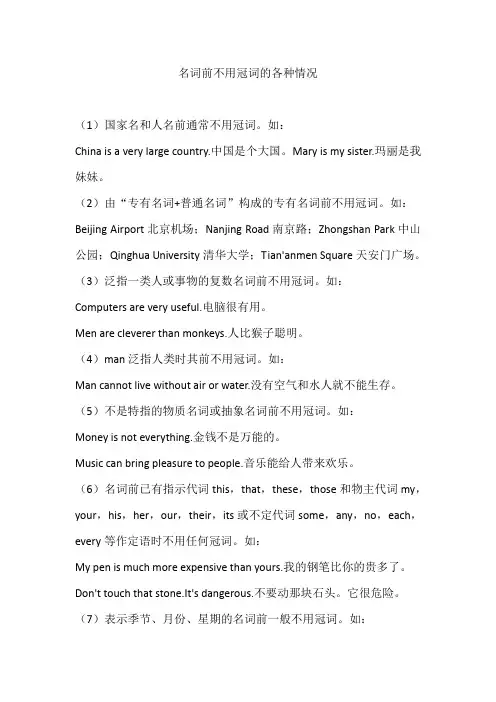
名词前不用冠词的各种情况(1)国家名和人名前通常不用冠词。
如:China is a very large country.中国是个大国。
Mary is my sister.玛丽是我妹妹。
(2)由“专有名词+普通名词”构成的专有名词前不用冠词。
如:Beijing Airport北京机场;Nanjing Road南京路;Zhongshan Park中山公园;Qinghua University清华大学;Tian'anmen Square天安门广场。
(3)泛指一类人或事物的复数名词前不用冠词。
如:Computers are very useful.电脑很有用。
Men are cleverer than monkeys.人比猴子聪明。
(4)man泛指人类时其前不用冠词。
如:Man cannot live without air or water.没有空气和水人就不能生存。
(5)不是特指的物质名词或抽象名词前不用冠词。
如:Money is not everything.金钱不是万能的。
Music can bring pleasure to people.音乐能给人带来欢乐。
(6)名词前已有指示代词this,that,these,those和物主代词my,your,his,her,our,their,its或不定代词some,any,no,each,every等作定语时不用任何冠词。
如:My pen is much more expensive than yours.我的钢笔比你的贵多了。
Don't touch that stone.It's dangerous.不要动那块石头。
它很危险。
(7)表示季节、月份、星期的名词前一般不用冠词。
如:He was born on February 18,2005.他出生在2005年2月18日。
They usually plant trees on the hills in spring.春天他们通常在山上植树。

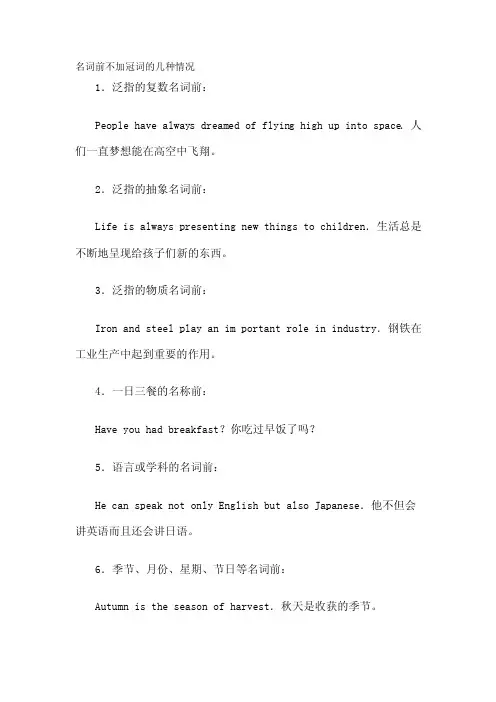
名词前不加冠词的几种情况1.泛指的复数名词前:People have always dreame d of flying high up into space.人们一直梦想能在高空中飞翔。
2.泛指的抽象名词前:Life is always presen tingnew things to childr en.生活总是不断地呈现给孩子们新的东西。
3.泛指的物质名词前:Iron and steelplay an im portan t role in indust ry.钢铁在工业生产中起到重要的作用。
4.一日三餐的名称前:Have you had breakf ast?你吃过早饭了吗?5.语言或学科的名词前:He can speaknot only Englis h but also Japane se.他不但会讲英语而且还会讲日语。
6.季节、月份、星期、节日等名词前:Autumn is the season of harves t.秋天是收获的季节。
June 1st is Childr en's Day.六月1日是儿童节。
We have Englis h classe s on Monday and Thursd ay.我们周一和周四有英语课。
7.球类运动或棋类游戏名称前:They all like to play footba ll.他们都喜欢踢足球。
8.有物主代词、指示代词、不定代词等修饰的名词前:Each age has its pleasu res and pains.每个年龄层次有不同的乐趣和苦恼。
I want this car,not that car.我想要这辆小汽车,不是那辆。
Thereis some waterin the cup.杯子里面有些水。
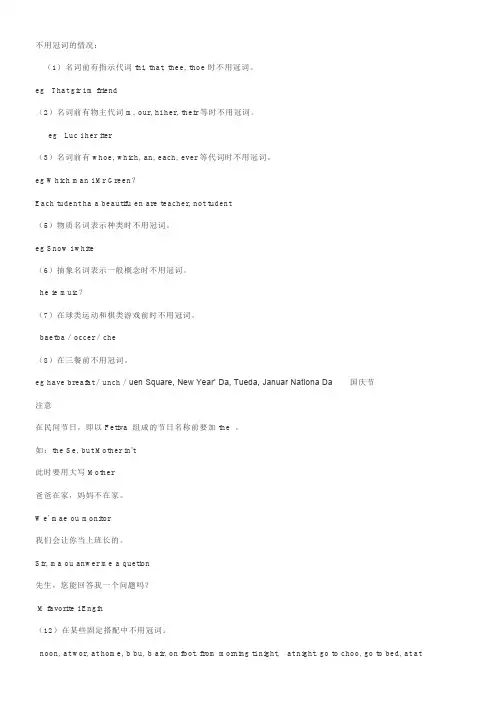
不用冠词的情况:(1)名词前有指示代词thi, that, thee, thoe时不用冠词。
eg That gir i m friend(2)名词前有物主代词m, our, hi her, their等时不用冠词。
eg Luc i her iter(3)名词前有whoe, which, an, each, ever等代词时不用冠词。
eg Which man i Mr Green?Each tudent ha a beautifu en are teacher, not tudent(5)物质名词表示种类时不用冠词。
eg Snow i white(6)抽象名词表示一般概念时不用冠词。
he ie muic?(7)在球类运动和棋类游戏前时不用冠词。
baetba/occer/che(8)在三餐前不用冠词。
eg have breafat/unch/uen Square, New Year’ Da, Tueda, Januar Nationa Da国庆节注意在民间节日,即以Fetiva 组成的节日名称前要加the 。
如:the Se, but Mother in't此时要用大写Mother爸爸在家,妈妈不在家。
We' mae ou monitor我们会让你当上班长的。
Sir, ma ou anwer me a quetion先生,您能回答我一个问题吗?M favorite i Engih(12)在某些固定搭配中不用冠词。
noon, at wor, at home, b bu, b air, on foot, from morning ti night, at night, go to choo, go to bed, at at4在有些词组中,用冠词和不用冠词意思有较大区别。
in ho,ome等时就不用冠词。
V冠词的易错点:1It' time for dinner King are at tabeA /,theB the, theC The,/ D/,/答案: C 在姓氏复数前用the表示一家人,就餐用at tabe2-What do ou uua have for breafat-I often have bread and miA/,/ B/,the C a,/ D the, the答案: A 物质名词前一般不用冠词。
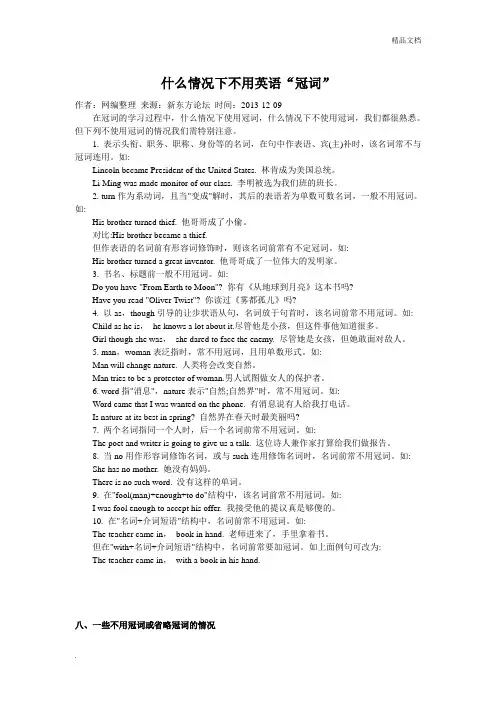
什么情况下不用英语“冠词”作者:网编整理来源:新东方论坛时间:2013-12-09在冠词的学习过程中,什么情况下使用冠词,什么情况下不使用冠词,我们都很熟悉。
但下列不使用冠词的情况我们需特别注意。
1. 表示头衔、职务、职称、身份等的名词,在句中作表语、宾(主)补时,该名词常不与冠词连用。
如:Lincoln became President of the United States. 林肯成为美国总统。
Li Ming was made monitor of our class. 李明被选为我们班的班长。
2. turn作为系动词,且当"变成"解时,其后的表语若为单数可数名词,一般不用冠词。
如:His brother turned thief. 他哥哥成了小偷。
对比:His brother became a thief.但作表语的名词前有形容词修饰时,则该名词前常有不定冠词。
如:His brother turned a great inventor. 他哥哥成了一位伟大的发明家。
3. 书名、标题前一般不用冠词。
如:Do you have "From Earth to Moon"? 你有《从地球到月亮》这本书吗?Have you read "Oliver Twist"? 你读过《雾都孤儿》吗?4. 以as,though引导的让步状语从句,名词放于句首时,该名词前常不用冠词。
如:Child as he is,he knows a lot about it.尽管他是小孩,但这件事他知道很多。
Girl though she was,she dared to face the enemy. 尽管她是女孩,但她敢面对敌人。
5. man,woman表泛指时,常不用冠词,且用单数形式。
如:Man will change nature. 人类将会改变自然。
Man tries to be a protector of woman.男人试图做女人的保护者。
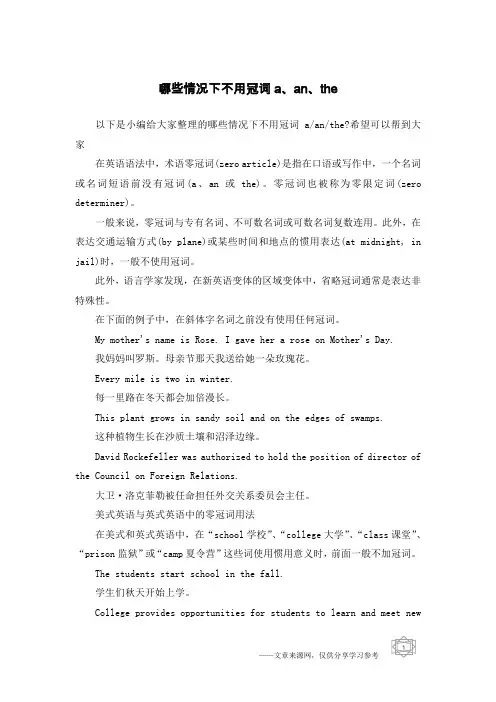
哪些情况下不用冠词a、an、the以下是小编给大家整理的哪些情况下不用冠词a/an/the?希望可以帮到大家在英语语法中,术语零冠词(zero article)是指在口语或写作中,一个名词或名词短语前没有冠词(a、an或the)。
零冠词也被称为零限定词(zero determiner)。
一般来说,零冠词与专有名词、不可数名词或可数名词复数连用。
此外,在表达交通运输方式(by plane)或某些时间和地点的惯用表达(at midnight, in jail)时,一般不使用冠词。
此外,语言学家发现,在新英语变体的区域变体中,省略冠词通常是表达非特殊性。
在下面的例子中,在斜体字名词之前没有使用任何冠词。
My mother's name is Rose. I gave her a rose on Mother's Day.我妈妈叫罗斯。
母亲节那天我送给她一朵玫瑰花。
Every mile is two in winter.每一里路在冬天都会加倍漫长。
This plant grows in sandy soil and on the edges of swamps.这种植物生长在沙质土壤和沼泽边缘。
David Rockefeller was authorized to hold the position of director of the Council on Foreign Relations.大卫·洛克菲勒被任命担任外交关系委员会主任。
美式英语与英式英语中的零冠词用法在美式和英式英语中,在“school学校”、“college大学”、“class课堂”、“prison监狱”或“camp夏令营”这些词使用惯用意义时,前面一般不加冠词。
The students start school in the fall.学生们秋天开始上学。
College provides opportunities for students to learn and meet newpeople.大学为学生们提供学习和结识新人的机会。
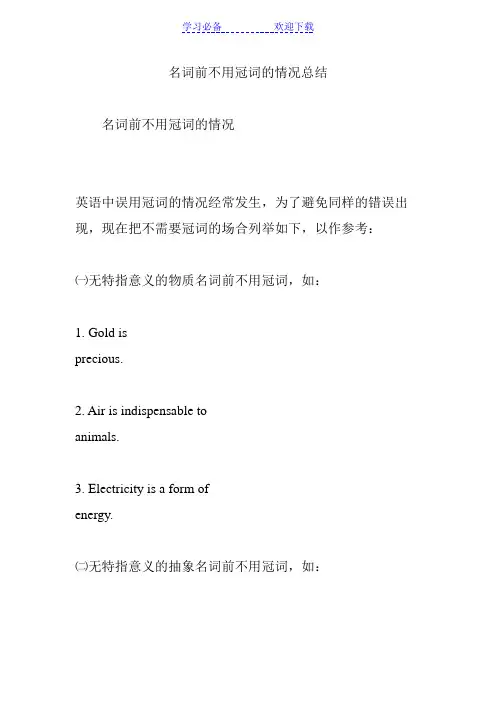
名词前不用冠词的情况总结名词前不用冠词的情况英语中误用冠词的情况经常发生,为了避免同样的错误出现,现在把不需要冠词的场合列举如下,以作参考:㈠无特指意义的物质名词前不用冠词,如:1. Gold isprecious.2. Air is indispensable toanimals.3. Electricity is a form ofenergy.㈡无特指意义的抽象名词前不用冠词,如:4. Unity isstrength.5. Knowledge ispower.6. Samson is a man of bravery.㈢无特指意义的复数名词前不用冠词,如:7. Doctors cure patients.8. Axes are tools for cutting wood.9. Those people are teachers, not students.㈣有关餐食的名词前不用冠词,如:10. Dinner isready.11. After lunch, you may take a nap.12.What do you eat for breakfast?㈤有关四季的名词前不用冠词,如:13. I like autumnmost.14. Do you have to teach insummer?15. Winter is over; will spring be far away?㈥有关游戏和运动的名词前不用冠词,如:16. Fandi can play soccer very well.17. Do yo like to playchess?18. Is bridge a popular game here?㈦有关疾病的名词前不用冠词,如:19. Old People tend to suffer from diabetes.20.Many women are inflicted withrheumatism(['ru:m?tiz?m,'ru-]n. 风湿病).㈧有关学科或带“-ism”后缀的名词前不用冠词,如:21. Mathematics and physics are difficultsubjects.22. Which do you prefer, imperialism ([im'pi?ri?liz?m]n. 帝国主义,capitalistimperialism:资本帝国主义) or communism?㈨在“by + 交通工具”的片语里名词前不用冠词,如:23. Shall we walk or go bybus?24. The tourists came byplane.25. Do you like to travel by land or by sea?㈩关于“人、节日、地理、建筑物、语言”等的专有名词前不用冠词,如:26. Tony wants to seeSusan.27. Christmas is a widely celebratedfestival.28. Europe is more advanced thanAfrica.29. Do you know where Buckingham Palaceis?30.Is Japanese similiar to Chinese?上述是无须冠词的例句,但当专有名词之前有修饰语时,可以用定冠词(例(31)-(32));当抽象名词被形容词、短语或分句修饰时,也可以有适当的冠词(例(33)-(36)):31. Caesar was an ancient hero. Do you admire the great Caesar andhisdeeds?32. We enjoy reading the great works written by the immortal([i'm?:t?l]adj.不朽的;神仙的;长生的)Shakespeare.33. A little knowledge is a dangerousthing.34. The wisdom of Solomon was recorded inhistory.35. Tom showed a courage worthy of specialmention.36. I find it hard to forget the generosity with which David treated me.。
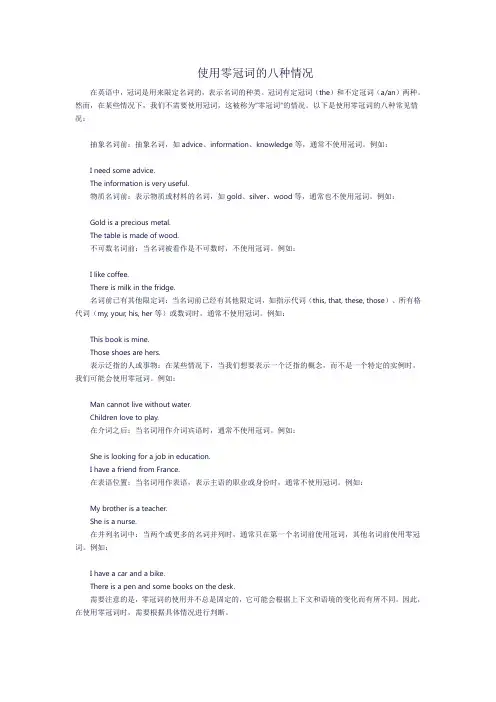
使用零冠词的八种情况在英语中,冠词是用来限定名词的,表示名词的种类。
冠词有定冠词(the)和不定冠词(a/an)两种。
然而,在某些情况下,我们不需要使用冠词,这被称为“零冠词”的情况。
以下是使用零冠词的八种常见情况:抽象名词前:抽象名词,如advice、information、knowledge等,通常不使用冠词。
例如:I need some advice.The information is very useful.物质名词前:表示物质或材料的名词,如gold、silver、wood等,通常也不使用冠词。
例如:Gold is a precious metal.The table is made of wood.不可数名词前:当名词被看作是不可数时,不使用冠词。
例如:I like coffee.There is milk in the fridge.名词前已有其他限定词:当名词前已经有其他限定词,如指示代词(this, that, these, those)、所有格代词(my, your, his, her等)或数词时,通常不使用冠词。
例如:This book is mine.Those shoes are hers.表示泛指的人或事物:在某些情况下,当我们想要表示一个泛指的概念,而不是一个特定的实例时,我们可能会使用零冠词。
例如:Man cannot live without water.Children love to play.在介词之后:当名词用作介词宾语时,通常不使用冠词。
例如:She is looking for a job in education.I have a friend from France.在表语位置:当名词用作表语,表示主语的职业或身份时,通常不使用冠词。
例如:My brother is a teacher.She is a nurse.在并列名词中:当两个或更多的名词并列时,通常只在第一个名词前使用冠词,其他名词前使用零冠词。
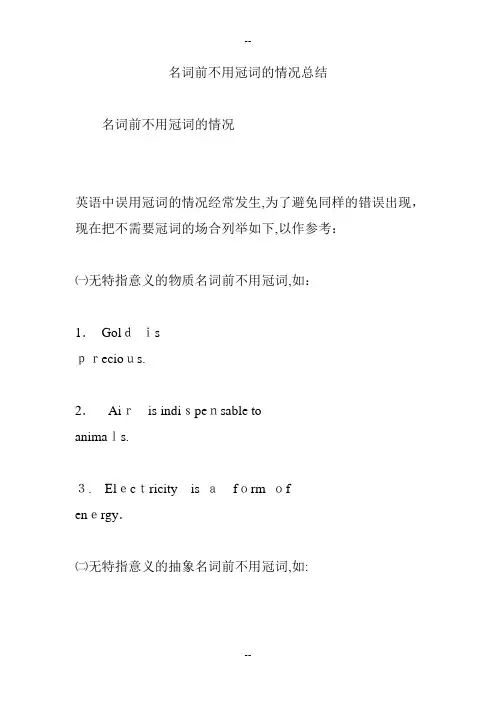
名词前不用冠词的情况总结名词前不用冠词的情况英语中误用冠词的情况经常发生,为了避免同样的错误出现,现在把不需要冠词的场合列举如下,以作参考:㈠无特指意义的物质名词前不用冠词,如:1.Goldisprecious.2.Airis indispensable toanimals.3.Electricity is aform ofenergy.㈡无特指意义的抽象名词前不用冠词,如:4.Unity isstrength.5. Knowledge ispower.6.Samson is aman of bravery.㈢无特指意义的复数名词前不用冠词,如:7. Doctors cure patients.8. Axes are toolsfor cutting wood.9.Those people are teachers,notstudents.㈣有关餐食的名词前不用冠词,如:10.Dinnerisready.11. Afterlunch, you maytake a nap.12.What do youeatforbreakfast?㈤有关四季的名词前不用冠词,如:13. I like autumnmost.14. Do you havetoteach insummer?15. Winter is over; will spring be faraway?㈥有关游戏和运动的名词前不用冠词,如:16. Fandi can play soccerverywell. 17. Doyoliketo playchess?18. Isbridge apopulargamehere? ㈦有关疾病的名词前不用冠词,如:19. Old People tendto suffer fromdiabetes.20.Many women areinflicted withrheumatism(['ru:m?tiz?m,'ru-]n. 风湿病).㈧有关学科或带“-ism”后缀的名词前不用冠词,如:21.Mathematics and physics are difficultsubjects.22. Which do you prefer, imperialism([im'pi?ri?liz?m]n. 帝国主义,capitalistimperialism:资本帝国主义)or communism?㈨在“by+ 交通工具”的片语里名词前不用冠词,如:23.Shall we walkor go bybus?24.The tourists came byplane.25.Doyou liketotravel by land or by sea?㈩关于“人、节日、地理、建筑物、语言”等的专有名词前不用冠词,如:26. Tony wants to seeSusan.27.Christmasis a widely celebrated festival.28. Europeis moreadvanced thanAfrica.29. Doyou knowwhere Buckingham Palaceis?30.Is Japanese similiar to Chinese?上述是无须冠词的例句,但当专有名词之前有修饰语时,可以用定冠词(例(31)-(32));当抽象名词被形容词、短语或分句修饰时,也可以有适当的冠词(例(33)-(36)):31.Caesar was anancient hero.Do you admire the greatCaesar andhisdeeds?32.We enjoy reading thegreatworks written by theimmortal([i'm?:t?l]adj.不朽的;神仙的;长生的)Shakespeare.33. A little knowledgeis a dangerousthing.34. Thewisdom of Solomonwasrecordedinhistory.35. Tomshowed a courageworthy of special mention.36. I findit hard toforget thegenerositywithwhich Davidtreated me.。
一些不用冠词的情况:1. 专有名词和(第一次使用)一些不可数名词时前面通常不用:国家、语种、颜色等:America,England,ChinaAnn comes from Australia. 安来自澳大利亚。
Man needs air and water.(人类需要空气和水)Blue is my favorite color. 蓝色是我最喜欢的颜色He can speak Japanese. 他会说日语。
注:国家里面由复合词组成的国家名要加定冠词the,比如the United States,the United Kingdom2.在表示交通工具和学科名词的名词前不加冠词。
如:by car 坐汽车by ship 坐船by plane 坐飞机on foot 步行mathematics 数学physics 物理chemistry 化学3.名词前已有指示、物主代词、不定代词或所有格修饰时不用。
指示代词this,that,these,those;(this man)不定代词some,any. (some books)所有格形式就是平时说的's. (peter's book)My pen is much more expensive than yours.(我的钢笔比你的昂贵多了)4.季节、星期、月份前一般不用。
Summer is hot and days are longer. 夏天热,白天长。
September 10th is Teachers’ Day.It’s Wednesday today. 今天是星期三。
5.可数名词复数用于一般意义时,不加冠词。
(表示泛指)They are teachers.他们是老师。
Tigers like meat.老虎喜欢吃肉Books may not be taken out of the library. 图书馆的图书不得携出馆外。
注:如果复数名词表示特指,则在其前用定冠词The books sold out in a week. 书在一周内售完了。
不用冠词的场合有哪些冠词是用在名词前面,帮助说明名词所指的人或事物的词语,在英语中,有些场合是不需要加冠词的。
小编为大家力荐了不用冠词的场合,给大家作为参考,欢迎阅读!不用冠词的场合①抽象、物质名词和专有名词一般无冠词,但物质名词、抽象名词具体化,或专有名词泛指时,常用不定冠词,例:a Mr Wang/a climb/a swim.for a while/in a hurry/a fire Here is a life of struggle.Physics is a science. There was a heavy rain last night.等抽象名词受of短语修饰或上下文已予限定,用the.如:the science of speech sounds 语音学the music of the film, do me the favor to do sth.②代数词、基数词作前置定词,不用冠词。
③泛指的节假日、季节、星期前不用冠词。
但是季节名词表特定时间或受of知识修饰时用the.如:in the winter of 1948。
有时泛指时间用a+adj+名词。
如:have a hot summer.④餐名前一般无冠词。
但餐名受adj修饰时常常有a(an).特指时用the.如:have a good supper. The breakfast was well cooked.dinner表“宴会”时,是可数名词,有各种冠词修饰give a dinner to them.⑤普通名词并列时不用冠词soul and heart/husband and wife/day after day/arm in arm/hand in hand.⑥语种前不用冠词。
但the English结构用the。
What's the English for labour.The English of shakespear.作限定时用the.不用冠词的语法顺口溜抽象、物质、专有名,代词基数用作限定;泛指节假季节星期几,球棋、呼语与餐名;刊物、公告与标题,普通名词并列紧相邻;唯一职位,学科与语种,洲、国、省、市、县街路名。
定冠词的省略1、某些国家名称、机关团体、阶级等的专有名词前的定冠词通常省略。
但是这些表示国家名称、机关团体、阶级等的专有名词是由两个或两个以上的普通名词构成的话,前面必须加上定冠词the.比如:He comes from American, he is American. 他来自美国,他是美国人。
the People’s Republic of China.中华人民共和国the United States 美国2、在季节、月份、节日、假日、日期、星期等表示时间的名词前,不加冠词。
比如:We go to school from Monday to Friday.我们从星期一到星期五都上课。
3、在三餐、球类运动和娱乐运动的名词前,不加冠词。
比如:We have breakfast at seven in the morning.我们早上七点吃早饭。
Tommy likes playing chess very much.汤米非常喜欢下象棋。
4、当两个或两个以上名词并用时,常省去冠词。
比如:I can’t write without pen or pencil.没有钢笔和铅笔,我就写不了字。
5、在称呼或表示官衔、职位的名词前不加冠词。
The students take him to President Lee.学生们带他去见李校长6、抽象名词表示一般概念时,常不加冠词。
Failure is the mother of success.失败是成功之母。
7、泛指的复数名词,表示一类人或事物,可不用定冠词。
They are teachers. 她们是老师。
8、物质名词表示一般概念时,通常不加冠词,当表示特定意思时,需加定冠词。
Man cannot live without water.人离开水就无法生存。
9、当by与火车等交通工具连用,表示一种方式时,中间无冠词。
I come to school by bus every day.我每天坐公共汽车去上学。
一些不用冠词的情况:1. 专有名词和(第一次使用)一些不可数名词时前面通常不用:国家、语种、颜色等:America,England,ChinaAnn comes from Australia. 安来自澳大利亚。
Man needs air and water.(人类需要空气和水)Blue is my favorite color. 蓝色是我最喜欢的颜色He can speak Japanese. 他会说日语。
注:国家里面由复合词组成的国家名要加定冠词the,比如the United States,the United Kingdom2.在表示交通工具和学科名词的名词前不加冠词。
如:by car 坐汽车by ship 坐船by plane 坐飞机on foot 步行mathematics 数学physics 物理chemistry 化学3.名词前已有指示、物主代词、不定代词或所有格修饰时不用。
指示代词this,that,these,those;(this man)不定代词some,any. (some books)所有格形式就是平时说的's. (peter's book)My pen is much more expensive than yours.(我的钢笔比你的昂贵多了)4.季节、星期、月份前一般不用。
Summer is hot and days are longer. 夏天热,白天长。
September 10th is Teachers’ Day.It’s Wednesday today. 今天是星期三。
5.可数名词复数用于一般意义时,不加冠词。
(表示泛指)They are teachers.他们是老师。
Tigers like meat.老虎喜欢吃肉Books may not be taken out of the library. 图书馆的图书不得携出馆外。
注:如果复数名词表示特指,则在其前用定冠词The books sold out in a week. 书在一周内售完了。
名词前不用冠词的15种情况名词前不用冠词的15种情况冠词是位于名词前用来说明该名词含义的虚词,可分为不定冠词(an, a)和定冠词(the)两类,但是在很多种情况下名词前却不用冠词(即用零冠词),主要有以下15种情况。
1.复数名词泛指一类人或物或表示不定量的人或物时, 通常用零冠词。
Festivals are meant to celebrate important times of year.节日就是庆祝一年中最重要的日子。
In some places women are expected to earn money while men work at home and raise their children.在一些地方, 妇女们去挣钱而男人在家照顾孩子。
考题链接(2010年江苏卷)The visitors here are greatly impressed by the fact that ______ people from all walks of life are working hard for ______ new Jiangsu.A.不填;aB.不填;theC.the;aD.the;the解析 A。
考查冠词的用法。
“people from all walks of life”意为“各行各业的人们”,表达的是泛指的概念,因此无需加定冠词;第二个空也表达的是泛指的概念,即“一个新的江苏”。
2.物质名词、抽象名词表示一般概念时, 通常用零冠词。
Do you want tea or coffee? 你想喝茶还是咖啡?It takes great imagination as well as patience to teach in a school for the blind.在盲人学校教书需要极大的耐心和想象力。
拓展记忆复数名词以及物质名词和抽象名词表示泛指时不用冠词,如表示特指时需用定冠词。
个人收集整理-ZQ
.泛指地复数名词前:
.人们一直梦想能在高空中飞翔.
.泛指地抽象名词前:
.生活总是不断地呈现给孩子们新地东西.
.泛指地物质名词前:
.钢铁在工业生产中起到重要地作用.
.一日三餐地名称前:
?你吃过早饭了吗?
.语言或学科地名词前:
.他不但会讲英语而且还会讲日语.
.季节、月份、星期、节日等名词前:
.秋天是收获地季节.
' .六月日是儿童节.
.我们周一和周四有英语课.
.球类运动或棋类游戏名称前:
.他们都喜欢踢足球.
.有物主代词、指示代词、不定代词等修饰地名词前:.每个年龄层次有不同地乐趣和苦恼.
,.我想要这辆小汽车,不是那辆.
.杯子里面有些水.
.大多数专有名词前:
?你知道上海地南京路吗?
.用作称呼语或表示头衔地名词前:
,?孩子,你在读什么?
.他是工厂地厂长.
.用于表示家庭成员或,,等具有(,)意义时:.老师对我们地工作很满意.
,.妈妈慢慢变成了典型地中年家庭主妇. .用于固定词组中:
.我儿子已经去上学了.
?你是乘火车旅行地吗?
.他们步行走了很远地路.
.上个星期天我们在小镇上过得很愉快.
'
.你不应该在孩子们面前说这样难听地话.
.作为回报我希望能为你
1 / 1。